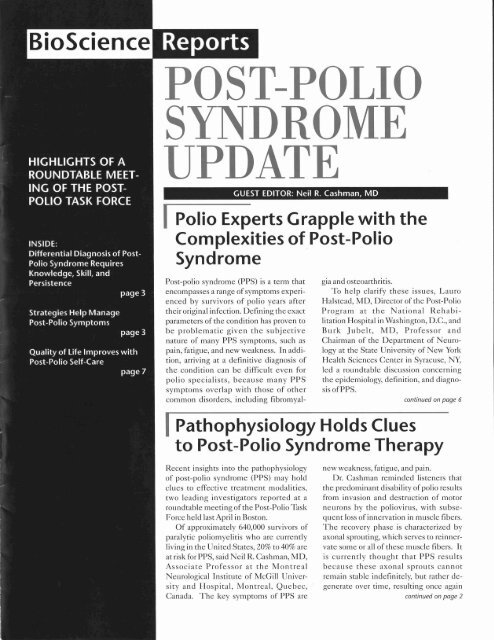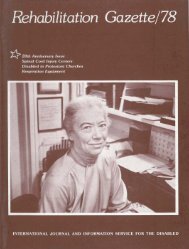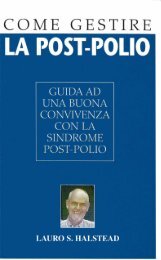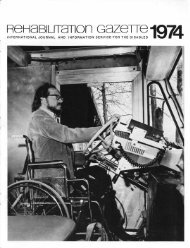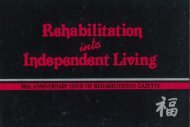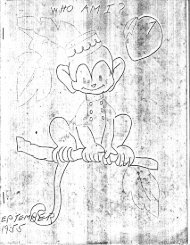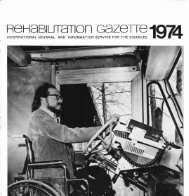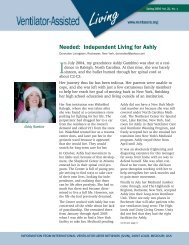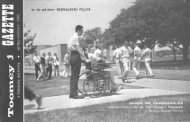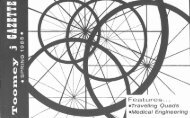Post-Polio Syndrome Update - Polio Place
Post-Polio Syndrome Update - Polio Place
Post-Polio Syndrome Update - Polio Place
You also want an ePaper? Increase the reach of your titles
YUMPU automatically turns print PDFs into web optimized ePapers that Google loves.
Pathophysiology<br />
i Holds Clues to<br />
PPS Therapy<br />
continued from page 1<br />
in denervation of the associated muscle<br />
fibers.<br />
Using electrodiagnostic tests, including<br />
single-fiber electromyography<br />
(SFEMG), and muscle biopsy analyses,<br />
including immunohistochemical evaluations<br />
of neural-cell adhesion molecule<br />
(N-CAM, a molecule expressed by denervated<br />
muscle fibers), researchers have<br />
identified ongoing muscle fiber denervation<br />
in post-polio patients (Figures 1<br />
and 2). Fibers that were denervated<br />
decades ago can be clearly differentiated<br />
from small, angulated fibers that<br />
have lost their innervation in recent<br />
weeks or months, Dr. Cashman noted.<br />
"To me, this is the best proof that there<br />
is terminal axonal degeneration going<br />
on in people who have had polio in the<br />
past," he said.<br />
Terminal Axonal Dysfunction<br />
Observed<br />
More recent work by Dr. Cashman's<br />
group has suggested that terminal axona1<br />
dysfunction may be even more common<br />
than terminal axonal degeneration.<br />
This research has identified normalsized<br />
myofibers expressing N-CAM<br />
(Figure 3); these may be fibers that have<br />
lost innervation and will ultimately<br />
become small, angulated fibers, or they<br />
may be only temporarily denervated<br />
and may be destined to become reinnervated,<br />
he said.<br />
"The interesting point is that small,<br />
continued on page 6<br />
Figure 1. Single-fiber electromyography (SFEMC) data from an asymptomatic, 64-year-old<br />
patient with prior paralytic polio. Shown are 10 superimposed action potentials demonstrating<br />
"jitter" associated with motor nerve terminal degeneration.<br />
Figure 2. Angular atrophic muscle fiber in rectus femoris of a PPS patient reporting one year of<br />
new leg weakness (hematoxylin eosin stain). Isolated angular atrophic fibers indicate recent<br />
motor nerve terminal degeneration.<br />
Figure 3. Neural-cell adhesion molecule (N-CAM) immunoreactivity in small- and large-diameter<br />
muscle fibers. N-CAM expression is associated with muscle denervation; normal-sized myofibers<br />
expressing N-CAM may be fibers that have lost innervation and will ultimately become small,<br />
angulated fibers, or they may be only temporarily denervated and may be destined to become<br />
reinnewated.<br />
I<br />
!<br />
i<br />
1<br />
i<br />
BioScience<br />
BIOSCIEXE REPORTS is a trademarked publication of BioScience Communications. This particular issue is supported by an<br />
educational grant from ICN Pharmaceuticals, Inc. The contents herein do not necessarily reflect the views or opinions of either<br />
BioScience Communications or ICN Pharmaceuticals. In all matters of scientific information, the Editorial Board has final authority.<br />
Copyright Q 1997. BioScience Communications, a division of Edelrnan Healthcare Worldwide. All rights reserved.<br />
Guest Editor: Seil R Cashman. %fD<br />
Editorial Board: The <strong>Post</strong>-<strong>Polio</strong> Task Force<br />
Frederick Xi. Maynard, riD<br />
Neil R. Cashman, 51D (Chairman)<br />
Lauro Halstead, 51D<br />
Joan L. Headley<br />
Burk Jubelt, lLlD<br />
Robert Lliller, 5fD<br />
Dorothy \T'oods Smith, RV, PhD<br />
Daria A. Trojan, LID, LlSc<br />
I<br />
I<br />
i
ifferential Diagnosis of <strong>Post</strong>-<br />
<strong>Polio</strong> ~ yndrom~ ~equires<br />
Knowledge, Skill, and Persistence t,anpps.<br />
said, diagnostic planning can be approached<br />
by examining the primary<br />
symptoms of pain, new weakness, and<br />
fatigue, and using appropriate evaluation<br />
tests to exclude conditions other<br />
In Dr. Maynard's algorithm, possible<br />
Diagnosing post-polio syndrome (PPS) rithm - developing a differential diag- causes for new weakness that should be<br />
is a challenging process. There are no nosis - involves not only defining the ruled out can be categorized according<br />
pathognomonic tests for the condition, basic characteristics of each symptom, to their association with one or more of<br />
and a definitive diagnosis can be but also considering the symptoms in the following conditions: new superimachieved<br />
only through exclusion of relation to the individual's overall health posed neurological conditions, disuse<br />
other conditions that may be responsi- and specific lifestyle. Once this is atrophy, overuse/chronic strain, and sysble<br />
for causing PPS-like symptoms, accomplished, a diagnostic plan can be temic comorbid medical conditions.<br />
such as pain, new weakness, and fa- developed. In general, Dr. Maynard continued on page 4<br />
tigue. A successful exclusionary diagno-<br />
sis of PPS depends on the knowledge, -<br />
skill, and persistence of the examining<br />
physician, according to<br />
Frederick M. Maynard, MD, Professor<br />
and Chairperson of Physical Medicine<br />
and Rehabilitation at Case Western<br />
Reserve University/MetroHealth Medical<br />
Center in Cleveland, Ohio.<br />
"Persistence is particularly important<br />
when it comes to diagnosing PPS,<br />
because it is not always possible to get to<br />
the bottom of the situation during just<br />
a few visits with the patient," Dr.<br />
Maynard said. "One diagnostic difficulty<br />
stems from the fact that a patient's<br />
symptoms may result from a synergy<br />
between post-polio residual neuromuscular<br />
dysfunction, orthopedic dysfunction,<br />
and other comorbid medical conditions."<br />
Diagnostic Algorithm<br />
The process of "teasing apart" synergistic<br />
dysfunctions in a patient can be simplified<br />
through the use of a diagnostic<br />
algorithm, according to Dr. Maynard<br />
(see Table).<br />
The first step of this algorithm was<br />
summarized during the roundtable discussion<br />
led by Drs. Lauro Halstead and<br />
Burk Jubelt (see article, page 1). The<br />
second step requires the development<br />
of a comprehensive functional history,<br />
which allows the examining physician to<br />
quantify increasing weakness. Potential<br />
tests of a patient's physical abilities<br />
include manual muscle testing; isometric<br />
strength measurement; joint rangeof-motion<br />
measurements; gait evaluation;<br />
and pulmonary function tests.<br />
The third step in the diagnostic algo-<br />
Table. Diagnostic Algorithm for <strong>Post</strong>-<strong>Polio</strong> <strong>Syndrome</strong><br />
1) Verrfy an original diagnosis of acute paralytic polio (APP)<br />
2) Evaluate the extent and severity of APP residua<br />
3) Develop a differential diagnosis of the presenting symptom complex<br />
4) Conduct diagnostic tests to exclude other conditions considered in the differential<br />
diagnosis<br />
5) (If no other conditions are found): Establish the patient's baseline function<br />
and develop a rehabilitation plan<br />
6) (If other conditions are found): Treat them and re-evaluate the patient later<br />
for rehabilitation needs<br />
Strategies Help Manage<br />
<strong>Post</strong>-<strong>Polio</strong> Symptoms<br />
Even though no specific treatment is<br />
currently available for post-polio syndrome<br />
(PPS), strategies are available to<br />
help improve symptoms such as weakness,<br />
pain, respiratory dysfunction, dysphagia,<br />
and fatigue. A variety of techniques<br />
were outlined by Daria A.<br />
Trojan, MD, MSc, Assistant Professor at<br />
McGill University's Montreal Neurological<br />
Institute and Hospital, Montreal,<br />
Quebec, Canada, and Robert<br />
Miller, MD, Chairman of the Department<br />
of Neurology at California Pacific<br />
Medical Center, San Francisco.<br />
Exercise for PPS patients has long<br />
been a topic of controversy, Dr. Trojan<br />
noted. In recent years, however, numerous<br />
studies have shown that judicious<br />
exercise can have a beneficial impact on<br />
weakness. Weakness may lessen in<br />
response to non-fatiguing strengthening<br />
exercises (isometric, isotonic, or isokinetic)<br />
and aerobic exercises. Improvements<br />
in muscle strength, power,<br />
work capacity, and economy of movement<br />
have been reported. Stretching<br />
exercises to decrease or prevent contractures<br />
may also be useful in patients with<br />
weakness.<br />
Nevertheless, patients must be careful<br />
to avoid overuse of muscles during<br />
exercise, she said. Furthermore, exercise<br />
should be avoided altogether in<br />
those who are extremely weak and<br />
fatigued. "Just the activities of daily living<br />
take all of their energy, and these<br />
patients should not be subjected to<br />
additional exercise," she explained.<br />
Weight loss can also help in the management<br />
of weakness, Dr. Trojan noted.<br />
Excess weight increases stress on postpolio<br />
muscles and joints, necessitating<br />
greater energy expenditure to perform<br />
activities of daily living.<br />
Orthoses, or braces, offer another<br />
method of managing weakness. These<br />
devices can be used to compensate for<br />
continued on page 4
1 Differential<br />
1 I<br />
Diagnosis<br />
continued from page 3<br />
The category of new superimposed<br />
neurological conditions includes entrapment<br />
neuropathies (such as those affecting<br />
the median nerve at the wrist and<br />
the ulnar nerve in the hand), generalized<br />
motor and/or sensory neuropathies,<br />
radiculopathies, spinal stenosis, and<br />
other neurological diseases (e.g., amyotrophic<br />
lateral sclerosis [ALS], multiple<br />
sclerosis [MS], myasthenia gravis).<br />
The most appropriate evaluation tests<br />
for these conditions, according to Dr.<br />
Maynard, are electrodiagnostic tests<br />
(electromyography and nerve conduction<br />
studies); x-rays and imaging studies;<br />
blood chemistries, including creatine<br />
kinase and thyroid function tests;<br />
and toxic metals screening. The algorithm<br />
follows a similar step-by-step<br />
process for the differential diagnosis of<br />
pain and fatigue in PPS.<br />
Practical Concerns<br />
Some roundtable participants expressed<br />
concern that this algorithm may<br />
require expertise beyond the range of<br />
many practicing physicians, most of<br />
whom rarely see polio survivors. Dr.<br />
Maynard agreed that such concerns<br />
were valid, but also pointed out that the<br />
emphasis of the algorithm was not turning<br />
clinicians into "instant experts" on<br />
PPS. "The real issue is - how do we<br />
help doctors recognize possible PPS in<br />
the first place, and how should it be distinguished<br />
from other conditions" Dr.<br />
Maynard said. "Some physicians may<br />
not feel comfortable in diagnosing specific<br />
orthopedic problems associated<br />
with PPS, while others may feel less<br />
comfortable diagnosing neurological<br />
difficulties. One benefit of this algorithm<br />
is that it can assist examining<br />
physicians in knowing when to refer<br />
their patients to outside experts."<br />
Once other conditions have been<br />
excluded through differential diagnosis,<br />
the examining physician can begin to<br />
establish a functional baseline for the<br />
patient in order to measure the progress<br />
of rehabilitation, Dr. Maynard said. A<br />
patient's baseline can be established<br />
through manual muscle testing, quantitative<br />
strength training, electromyography,<br />
and limb circumference measurements.<br />
The examining physician can<br />
also record the time it takes a patient to<br />
walk a given distance or to complete an<br />
activity of daily living, so that these<br />
times can be compared to those<br />
achieved after the patient has begun a<br />
rehabilitation program. A subjective<br />
measurement of baseline function can<br />
also be established by videotaping<br />
movements and functional activities of<br />
'1 Management<br />
Strategies<br />
continued from page 3<br />
joint instability secondary to weak muscles;<br />
to correct gait deviations; to control<br />
joint deformities secondary to weak<br />
muscles; and to reduce pain. Studies<br />
have shown that appropriate orthoses<br />
may improve the patient's ability to<br />
walk and their perception of walking<br />
safety, and may also relieve pain.<br />
Assistive devices such as canes, crutches,<br />
wheelchairs, and scooters may be<br />
useful as well.<br />
Techniques Reduce Pain<br />
PPS patients can experience pain as the<br />
result of muscular, joint or biomechanical,<br />
or neurologic problems. Dr. Trojan<br />
advised that muscular pain may be<br />
reduced by using pacing strategies,<br />
including taking rest periods during<br />
activities; using moist heat, ice, and/or<br />
stretching; using assistive devices; and<br />
instituting lifestyle modifications.<br />
Fibromyalgia, which occurs relatively<br />
frequently in post-polio patients, can<br />
be treated with amitriptyline, cyclobenzaprine,<br />
or fluoxetine, Dr. Trojan<br />
said. Also potentially helpful are aerobic<br />
exercise, relaxation techniques,<br />
heat, massage, and injection of local<br />
anesthetics. Pain resulting from joint<br />
and soft tissue abnormalities may<br />
improve with modification of extremity<br />
use, physiotherapy, orthoses, assistive<br />
devices, nonsteroidal anti-inflammatory<br />
drugs, steroid injections, or surgery.<br />
Another potential concern in PPS is<br />
respiratory dysfunction. Preventive<br />
measures (such as pneumococcal and<br />
the patient.<br />
"PPS is a complex syndrome that<br />
does not lend itself to easy evaluation,<br />
and it follows that rehabilitation of a<br />
patient requires considerable attention<br />
and persistence on the part of the physician,"<br />
Dr. Maynard concluded. "To be<br />
effective, rehabilitation must address<br />
issues relating to general health, symptom<br />
reduction, and functional enhancement,<br />
as well as those relating to the prevention<br />
of secondary disability." w<br />
influenza vaccinations) should be provided,<br />
she said, and reversible causes<br />
should be treated. Ventilatory assistance<br />
may be necessary in some cases;<br />
however, noninvasive methods are preferred<br />
due to an enhanced quality of life<br />
and decreased incidence of complications.<br />
For dysphagia, Dr. Trojan recommended<br />
dietary alterations, special<br />
breathing and swallowing techniques,<br />
eating larger meals earlier in the day, and<br />
avoiding eating when fatigued.<br />
Managing Fatigue<br />
Dr. Miller described several strategies<br />
for improving the common symptom of<br />
fatigue in patients with PPS. He<br />
explained that fatigue may manifest<br />
itself as a low energy state; as mental<br />
fatigue; as reduced muscular endurance;<br />
or as delayed recovery after exercise.<br />
Patients frequently experience all<br />
types.<br />
Healthcare professionals should help<br />
patients assess the ways in which energy<br />
is currently being expended, Dr. Miller<br />
said. It may be possible in many cases to<br />
identify methods of conserving energy,<br />
he noted. Judicious use of antidepressant<br />
medications may be appropriate for<br />
some, but not all, patients. Because<br />
sleep disturbances can play a major role<br />
in fatigue, efforts should be made to normalize<br />
sleep patterns. Amitriptyline<br />
may be useful in this regard, Dr. Miller<br />
said.<br />
As in the case of muscle weakness,<br />
fatigue symptoms can also be improved<br />
through therapeutic exercise. Studies<br />
have shown that patients who exercise<br />
enjoy better endurance, greater work
capability, and improved recovery after<br />
fatiguing activities. However, patients<br />
must be cautioned to start slowly. "The<br />
general caveat is if exercise produces<br />
fatigue, you have gone too far, and if the<br />
next day you have muscular pain, you<br />
have done too much," Dr. Miller said.<br />
"The 'no pain, no gain' aphorism that<br />
applies to normal, healthy athletes does<br />
not apply to PPS patients."<br />
Pharmacologic Therapies Assessed<br />
Dr. Trojan noted that several pharmacologic<br />
agents have recently been evaluated<br />
or are under evaluation for the<br />
treatment of weakness and/or fatigue in<br />
PPS patients (see Table). To date, small<br />
trials have found no significant effects<br />
of amantadine, prednisone, or human<br />
growth hormone. Conversely, some<br />
improvement has been evident with<br />
bromocriptine, selegiline, insulin-like<br />
growth factor I (IGF-I), and pyridostigmine.<br />
An open-label trial in 17 PPS<br />
patients found that improvement in<br />
fatigue with pyridostigmine was significantly<br />
associated with amelioration in<br />
neuromuscular junction transmission<br />
with edrophonium (a similar, short-acting<br />
intravenous agent). This suggests<br />
that fatigue in some patients with PPS<br />
is due to anticholinesterase-responsive<br />
neuromuscular junction transmission<br />
defects. In an open-label trial of pyridostigmine<br />
in 27 PPS patients, 64%<br />
reported an improvement in fatigue. A<br />
double-blind, placebo-controlled,<br />
crossover trial in 27 PPS patients concluded<br />
that pyridostigmine produced<br />
an improvement in some measures of<br />
fatigue and strength. Because of these<br />
encouraging results, a multicenter trial<br />
of pyridostigmine in 126 PPS patients is<br />
currently underway.<br />
"Thus far, pyridostigmine seems to<br />
be most promising," Dr. Trojan said.<br />
"However, other medications, such as<br />
IGF-1 and selegiline, should probably<br />
be investigated further."<br />
Whenever possible, PPS patients<br />
should not receive medications that<br />
have fatiguing effects or potential<br />
inhibitory actions at the neuromuscular<br />
junction, she noted. Agents that should<br />
be avoided include beta-blockers, benzodiazepines,<br />
certain anesthetics, some<br />
antibiotics (such as tetracycline and<br />
Table. Pharmacotherapy of <strong>Post</strong>-<strong>Polio</strong> <strong>Syndrome</strong>: Recent Trials<br />
Drug Category Type of Trial N Results in PPS<br />
Amantadine Anti-viral Randomized, 25 No significant<br />
placebo-con- improvement in<br />
trolled trial<br />
fatigue'<br />
Prednisone Steroid, Randomized, 17 No significant<br />
(high-dose) anti-inflammatory placebo-con- improvement in<br />
trolled trial<br />
strength or<br />
fatigue2<br />
Human Hormone Open trial 5 Little or no<br />
growth<br />
improvement in<br />
hormone<br />
muscle strength3<br />
Bromocriptine Dopamine <strong>Place</strong>bo-con- 5 Improvement<br />
receptor agonist trolled, cross- in fatigue<br />
over trial<br />
symptoms in<br />
3 patient9<br />
Selegiline Neuroprotective Case studies 2 Improvement in<br />
agent<br />
PPS symptomsS<br />
vdostigmine Anticholinesterase Open trials 1 7, 27<br />
<strong>Place</strong>bo-con- 27<br />
trolled, crossover<br />
trial<br />
Insulin-like Growth factor Randomized, 22<br />
growth<br />
placebofactor<br />
I (IGF-1)<br />
controlled trial<br />
lmprovement<br />
in fatig~e~,~<br />
lmprovement<br />
in fatigue,<br />
strength8<br />
-. --<br />
Improvement in<br />
recovery after<br />
exercise, no<br />
change in<br />
strength, fatigability9<br />
'Stein DP et al. A double-blind, placebo-controlled trial of amantadine for the<br />
treatment of fatigue in patients with the post-polio syndrome. Ann NY Acad Sci<br />
1995;753:29&302.<br />
2Dinsmore S et al. A double-blind, placebo-controlled trial of high-dose prednisone<br />
for the treatment of post-poliomyelitis syndrome. Ann NY Acad Sci 1995;<br />
753:303-313.<br />
3Gupta KL et al. Human growth hormone effect on serum ICF-1 and muscle<br />
function in poliomyelitis survivors. Arch Phys Med Rehabil1994;75:889-894.<br />
4Bruno RL et al. Bromocriptine in the treatment of post-polio fatigue. Am / Phys<br />
Med Rehabil1996;75:340-347.<br />
SBamford CR et al. <strong>Post</strong>polio syndrome response to deprenyl (selegiline). Int 1<br />
Neurosci 1993;71 :I 83-1 88.<br />
6Trojan DA et al. Anticholinesterase-responsive neuromuscular junction transmission<br />
defects in post-poliomyelitis fatigue. / Neurol Sci 1993;114:170-177.<br />
7Trojan DA, Cashman NR. An open trial of pyridostigmine in post-poliomyelitis<br />
syndrome. Can / Neurol Sci 1995;22:223-227.<br />
%eizert BP et al. Pyridostigmine effect on strength, endurance, and fatigue in<br />
post-polio patients (Abstract). Arch Phys Med Rehabil1994;75:1049.<br />
9Miller RG et al. The effect of recombinant insulin-like growth factor 1 upon exercise-induced<br />
fatigue and recovery in patients with post polio syndrome<br />
(Abstract). Neurology 1997 (in press).<br />
aminoglycosides), certain anticonvulsants<br />
(such as phenytoin), some antipsy-<br />
chotics (such as lithium and phenothiazines),<br />
and barbiturates. M
! Pathophysiology<br />
Holds Clues to<br />
PPS Therapy<br />
continued from page 2<br />
angulated fibers constitute something<br />
on the order of 1 % of the fibers that one<br />
can see on a muscle biopsy [of a patient<br />
with a history of polio], whereas the total<br />
N-CAM-positive fiber population can<br />
represent 10% or more of muscle fibers,<br />
strongly suggesting that there is an<br />
ongoing process that is much more common<br />
than the terminal degeneration of<br />
axons," Dr. Cashman said.<br />
In addition to the N-CAM data, there<br />
is substantial electrophysiologic evidence<br />
that suggests instability of nerve<br />
transmission at the neuromuscular junction<br />
(NMJ). A marked increase in<br />
SFEMG jitter (a measure of terminal<br />
axonal function and NMJ transmission)<br />
has been observed both in polio survivors<br />
who have no new symptoms and<br />
in those with PPS (see Figure 1, page 2).<br />
The increase in jitter has been shown to<br />
be correlated with the severity of the<br />
denervation.<br />
Terminal axonal dysfunction may<br />
simply represent an intermediate stage<br />
in the process of neuronal degeneration,<br />
Dr. Cashman noted. Alternatively, it<br />
may reflect the fact that motor units in<br />
polio-affected muscles are in a constant<br />
state of remodeling. As innervation is<br />
lost from one muscle fiber, he said, an<br />
axonal sprout is sent from another motor<br />
unit to innervate that fiber; this process<br />
continues back and forth. There may<br />
also be age-related changes in the trophic<br />
support of terminal axons, Dr.<br />
Cashman noted. Growth hormone<br />
secretion diminishes with aging, resulting<br />
in decreased levels of circulating<br />
insulin-like growth factor I (IGF-I),<br />
which plays an important role in the<br />
maintenance of terminal axons.<br />
Treatment Implications Noted<br />
Unlike degeneration, which is irreversible,<br />
nerve terminal dysfunction<br />
may be treatable. Dr. Cashman pointed<br />
out that one of the key functions of the<br />
terminal motor axon is to release acetylcholine<br />
in order to depolarize postsynaptic<br />
muscle fibers and induce contrac-<br />
tion. Nearly 50 years ago, studies found<br />
a defect in acetylcholine release in<br />
patients who had recovered from polio.<br />
"Defective release of acetylcholine<br />
waxes and wanes; it can be reversible<br />
and fluctuant," he noted. "Fatigability<br />
is the sort of symptom that we should be<br />
on the lookout for, because it may be<br />
responsive to pharmaceutical therapy."<br />
Dr. Cashman explained that the<br />
defect in acetylcholine release is<br />
reversible with injection of the anticholinesterases<br />
neostigmine or edrophonium,<br />
which increase the amount of<br />
acetylcholine in the NMJ by inhibiting<br />
its breakdown. Interestingly, Dr.<br />
Cashman noted, response to the anticholinesterase<br />
pyridostigmine can be<br />
predicted on the basis of a positive<br />
SFEMG edrophonium response (i.e.,<br />
the same patients who respond to edrophonium<br />
will also experience improvement<br />
in fatigue with oral pyridostigmine<br />
therapy).<br />
Overuse Hypothesis Described<br />
Burk Jubelt, MD, Professor and<br />
Chairperson of the Department of<br />
Neurology at the State University of<br />
New York Health Sciences Center in<br />
Syracuse, pointed out that neither<br />
increasing fiber density nor presence of<br />
angulated muscle fibers can serve to differentiate<br />
symptomatic from asymptomatic<br />
polio survivors. However, he said,<br />
several clinical studies have demonstrated<br />
that excessive strengthening exercise<br />
of partially denervated muscles can lead<br />
to progressive weakness. Animal experiments<br />
have also shown that overwork of<br />
weak and partially denervated muscles<br />
results in more weakness.<br />
In light of these observations, Dr.<br />
Jubelt suggested that overuse of already<br />
weakened muscles accelerates the<br />
breakdown of the remaining motor<br />
units, resulting in additional weakness.<br />
From this perspective, post-poliomyelitis<br />
progressive muscular atrophy<br />
can be classified as a secondary phenomenon<br />
resulting from overstress of<br />
motor units for many years in compensation<br />
for residual weakness. Nonfatiguing<br />
exercise can help reverse the<br />
process and may even improve strength<br />
by avoiding overstress of the already<br />
weakened muscles, he said.<br />
<strong>Polio</strong> Experts<br />
Grapple with<br />
Complexities<br />
of PPS<br />
continued from page 1<br />
Definitive Data Lacking<br />
A 1987 National Center for Health<br />
Statistics survey found that there are<br />
640,000 survivors of paralytic polio in<br />
the United States, and that roughly half<br />
have reported new manifestations of the<br />
disorder. A 1991 survey by Windebank<br />
et a1 showed that 64% of survivors of paralytic<br />
polio experienced new manifestations<br />
and 44% had weakness. The<br />
results of a 1987 survey by Speier et a1<br />
indicated a lower prevalence of postpolio<br />
symptoms - 42% of respondents<br />
reported new problems, including pain,<br />
decreased endurance, and increased<br />
weakness - while a 1992 study by<br />
Ramlow et a1 found that 28% of paralytic<br />
polio survivors suffered from new neuromuscular<br />
symptoms. Thus, based<br />
upon symptoms, about half of acute paralytic<br />
poliomyelitis (APP) survivors go<br />
on to develop PPS. However, Dr. Jubelt<br />
noted, objective criteria need to be<br />
applied to more accurately determine<br />
the incidence of PPS. Uncontrolled,<br />
retrospective studies using<br />
objective criteria have estimated that<br />
20%-40% of APP survivors will develop<br />
PPS. "Obviously, we need better epidemiological<br />
data," he said.<br />
Towards a Definition of PPS<br />
PPS may be defined as a cluster of<br />
symptoms experienced by individuals<br />
who had paralytic polio years earlier, Dr.<br />
Halstead said. Typically, these symptoms<br />
occur 30 to 50 years after the initial<br />
illness, and include new weakness,<br />
fatigue, and pain in the muscles and/or<br />
joints. Less common symptoms can<br />
include muscle atrophy, breathing and<br />
swallowing difficulties, and intolerance<br />
to cold.<br />
According to Dr. Halstead, it is useful<br />
to categorize PPS symptoms into two<br />
groups: 1) those that are caused by a progressive<br />
deterioration of motor neurons<br />
(e.g., new weakness, fatigue, and muscle<br />
atrophy); and 2) those that are sec-
Table. Diagnostic Criteria for <strong>Post</strong>-<strong>Polio</strong> <strong>Syndrome</strong> (PPS)<br />
ties, such as providing them with assistive<br />
devices, you reduce the stress on<br />
1. A prior episode of paralytic poliomyelitis with residual motor neuron loss already overburdened muscles and<br />
(which can be confirmed through a typical patient history, a neurologic motor neurons, which in turn reduces<br />
examination, and, if needed, an electrodiagnostic exam)<br />
the progression of weakness in these<br />
patients. I think something similar<br />
2. A period of neurologic recovery followed by an interval (usually 15 years<br />
could have happened in the two studies<br />
or more) of neurologic and functional stability<br />
in question - even though the<br />
3. A gradual or abrupt onset of new weakness and/or abnormal muscle fatiresearchers<br />
gability (decreased endurance), with or without generalized fatigue, mus- pie tely<br />
cle atrophy, and/or pain<br />
inevitably influenced the study participants'<br />
daily activities and, subsequently,<br />
4. Exclusion of medical, orthopedic, and/or neurologic conditions that may effected long-term changes in the parbe<br />
causing the symptoms mentioned in (3)<br />
ticipants' health."<br />
Roundtable participant Neil<br />
These criteria represent a consensus statement of the <strong>Post</strong>-<strong>Polio</strong> Task<br />
Cashman, MD concurred with Dr.<br />
Force. The sensitivity, speciticity, and reliability of these criteria have not<br />
lubelt3s assessment that progressive<br />
yet been tested in a prospective manner.<br />
ondary to musculoskeletal changes (e.g.,<br />
muscle and joint pain from osteoarthritis,<br />
tendinitis, ligament strains, and joint<br />
deformities); the musculoskeletal<br />
changes may be a result of years of abnormal<br />
wear and tear and/or new weakness.<br />
"I believe that new weakness is the<br />
hallmark symptom of PPS," Dr.<br />
Halstead said. "When new weakness<br />
appears in muscles previously affected<br />
by polio and/or muscles thought to be<br />
unaffected originally, it may or may not<br />
be accompanied by other symptoms.<br />
This is a crucial point to recognize - a<br />
patient can have PPS even if new weakness<br />
is the only symptom."<br />
However, "weakness" is a notoriously<br />
difficult symptom to pin down, roundtable<br />
participants noted, and they<br />
expressed concern that some patients<br />
may be confusing "weakness" with<br />
"decreased endurance." To cloud the<br />
picture even further, there is evidence<br />
that some patients may experience subjective<br />
feelings of increased weakness in<br />
response to muscle pain, cramps, and<br />
soreness. Several investigators (Dalakas<br />
et al, 1986; Stilberg and Grimby, 1995;<br />
Agre et al, 1995) have shown a slow (1%-<br />
2% per year) decline in muscle strength<br />
in post-polio patients based on objective<br />
criteria; however, noted some roundtable<br />
participants, two 1996 studies of<br />
polio survivors by Windebank et a1 and<br />
Ivanyi et al failed to find a progressive<br />
decline in muscle strength, even in those<br />
patients who reported this symptom. In<br />
the study by Windebank et al, which<br />
involved 50 subjects, muscle strength<br />
tests, functional analyses, and electrophysiologic<br />
tests detected no evidence<br />
of progression over a 5-year period.<br />
Similarly, Ivanyi et a1 examined 56 polio<br />
survivors - 43 complaining of new progressive<br />
muscle weakness and 13 without<br />
new neuromuscular complaints -<br />
and found that there were no significant<br />
differences in reduction of muscle<br />
strength between the two groups after a<br />
mean period of 2.1 years.<br />
Dr. Jubelt pointed out that lack of<br />
adequate control in the studies for modification<br />
of the patients' daily activities<br />
could help to explain some of the discrepancies<br />
in reported prevalence of<br />
new weakness. "When you make positive<br />
changes in a patient's daily activi-<br />
new weakness does occur in this<br />
patient population. "We have all seen<br />
this manifestation in our patients. The<br />
question is not whether increasing<br />
weakness exists as a symptom of PPS,<br />
but rather, when patients complain of<br />
weakness, is it actually due to increasing<br />
weakness or is it due to another<br />
cause, such as increased joint pain or<br />
decreased endurance I believe that it<br />
is an endurance problem in most<br />
patients."<br />
Diagnostic Criteria for PPS<br />
Despite the difficulties in defining and<br />
identifying PPS symptoms such as<br />
"weakness" and "decreased endurance,"<br />
roundtable members agreed on<br />
some general diagnostic criteria for PPS<br />
(see Table). Ultimately, Dr. Halstead<br />
noted, the diagnosis of PPS is one of<br />
exclusion (see article, page 3).<br />
[ Qualityof Life Improves<br />
with <strong>Post</strong>-<strong>Polio</strong> Self-care<br />
Promotion of the concept of self-care can<br />
help to optimize wellness in patients<br />
with post-polio syndrome (PPS), according<br />
to Joan L. Headley, Executive<br />
Director of the International <strong>Polio</strong><br />
Network, St. Louis, Missouri. "In the<br />
absence of a cure, polio survivors experiencing<br />
PPS should focus on care-medical,<br />
psychological, social, and spiritual,"<br />
she said. "Good care can improve the<br />
quality of life for polio survivors and is<br />
most likely to happen when a patient<br />
and practitioner work in partnership."<br />
To establish such a partnership, she<br />
said, it may be helpful for the physician<br />
to recognize differences between the<br />
"medical approach" and the "independent-living<br />
approach" to the management<br />
of PPS. The medical approach is<br />
oriented towards the professional; it<br />
emphasizes the illness, and focuses on<br />
the treatment of symptoms and the need<br />
to find a cure. The independent-living<br />
continued on page 8
\ Quality of Life<br />
groups can be beneficial.<br />
36% fewer visits to their managed care<br />
Lifestyle changes that PPS patients facility.<br />
lmpro~es with have found especially beneficial include Dr. Woods Smith recommended that<br />
I '<br />
the employment of household help, the physicians ask patients whether they are<br />
Self-care acquisition of special equipment and already using alternative therapies. In a<br />
furniture, and making modifications in 1993 report by David Eisenberg, MD,<br />
continued from page 7 the layout of the home.<br />
approach is patient and family centered;<br />
it promotes a sense of health and wellbeing<br />
and encourages patients to take<br />
responsibility for their role in the decision-making<br />
process.<br />
"Physicians can validate polio survivors<br />
by listening to them and acknowledging<br />
that what they are experiencing<br />
is real, treating them with empathy<br />
while drawing upon their medical and<br />
diagnostic repertoire," Ms. Headley<br />
advised. "By working together as partners,<br />
physicians and polio survivors can<br />
develop options, choose strategies, and<br />
implement changes."<br />
Strategies Reviewed<br />
When coping strategies are directed<br />
toward symptoms and attempts to maintain<br />
previous activity levels, patients<br />
tend to feel more helpless, depressed,<br />
and angry, Ms. Headley explained, citing<br />
a study by Westebrook et al. According<br />
to that 1996 study of polio survivors,<br />
helpful personal strategies<br />
include: 1) becoming more involved in<br />
activities that one is still able to pursue,<br />
2) developing a philosophy of life, and 3)<br />
learning more about PPS. The ability to<br />
ask family and friends for assistance is<br />
particularly important, and interaction<br />
with other polio survivors in support<br />
Complementary Treatment<br />
Explored<br />
Dorothy Woods Smith, RN, PhD,<br />
Associate Professor at the University of<br />
Southern Maine College of Nursing,<br />
Portland, pointed out that debilitating<br />
pain and fatigue may persist even after<br />
PPS has been treated with surgery, pharmacologic<br />
therapy, and assistive<br />
devices. Ideally, she said, the physician<br />
should consider expanding the treatment<br />
plan to include complementary<br />
therapies aimed at lessening fatigue,<br />
relieving pain, reducing distress, and<br />
improving the quality of life.<br />
Of particular interest are self-care<br />
techniques for eliciting a relaxation<br />
response, Dr. Woods Smith observed.<br />
Such methods include meditation, progressive<br />
muscle relaxation, and some<br />
yoga practices. In a study relevant to<br />
polio survivors conducted at the<br />
Harvard-New England Deaconess<br />
MindIBody Medical Institute Pain<br />
Program, Margaret Caudill, MD, PhD,<br />
demonstrated that regular elicitation of<br />
the relaxation response resulted in an<br />
increase in activity, and decreases in<br />
pain severity, anxiety, depression, and<br />
anger. In the first year after completing<br />
the relaxation program, patients had<br />
and colleagues at Beth Israel Hospital<br />
and Harvard Medical School, 61 million<br />
Americans were estimated to be using<br />
some form of unconventional medicine.<br />
The most commonly reported therapies<br />
were acupuncture, relaxation techniques,<br />
and participation in self-help<br />
groups. The vast majority of individuals<br />
- 72% - had not told their physicians<br />
about using these modalities.<br />
"Most of these therapies have been<br />
reported by at least some polio survivors<br />
as helpful in reducing stress, pain,<br />
fatigue, or psychological distress," she<br />
said. She acknowledged, however, that<br />
"with the rapid proliferation of new<br />
therapies, it is often difficult to distinguish<br />
the authentic from the exploitative."<br />
Reliable information can be<br />
obtained from sources such as the Office<br />
of Alternative Medicine at the National<br />
Institutes of Health; the American<br />
Holistic Medical Association; or Alternative<br />
and Complementary Medicine, a<br />
journal edited by physicians, Dr. Woods<br />
Smith noted.<br />
"Ideally, physicians and polio survivors<br />
participating in partnerships with<br />
one another and with other health care<br />
providers will integrate the art and the<br />
science of medicine to offer the widest<br />
possible range of choices for healing,"<br />
she concluded.<br />
BioScience Communications<br />
1500 Broadway<br />
New York, New York 10036


